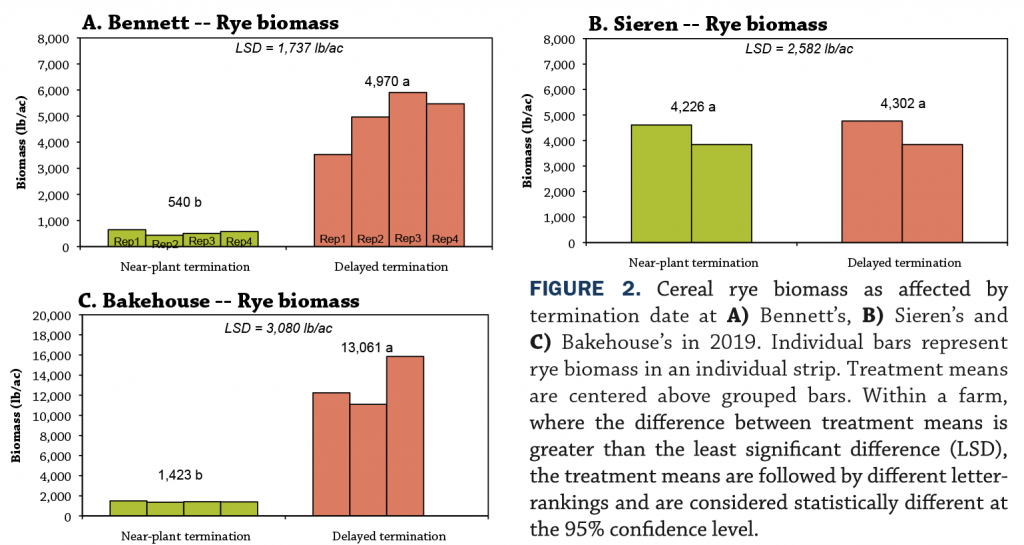This project is supported in part by the Iowa Department of Agriculture and Land Stewardship, Division of Soil Conservation and Water Quality.
In a Nutshell:
- While maximizing the benefits of cover crops requires extending their growing period, prolonging growth and delaying termination beyond the date of soybean emergence is not allowed under federal crop insurance rules.
- Sam Bennett, Tim Sieren and Jon Bakehouse compared cereal rye biomass, soybean stand counts and soybean yield between strips in which a rye cover crop was terminated near the date of planting soybean (near-plant termination) and strips in which rye termination was delayed until 16 to 52 days after planting (delayed termination).
Key Findings:
- By delaying termination, Bennett was able to increase rye biomass on his field without reducing soybean yield. Sieren’s yields were also unaffected, but soybean stand counts were reduced and he was unable to increase rye biomass. Bakehouse increased rye biomass without reducing soybean stand count.
- As a result of this trial, Bennett and Sieren plan to continue the practice of delaying rye termination in soybeans. Bennett and Bakehouse plan to conduct a similar experiment in 2020 but will add a treatment in which the rye reseeds itself and grows without being terminated.
Background
Benefits of cover crops can include improved weed control, reduced herbicide inputs, increased water infiltration and improvement of soil health and water quality.[1–3] Adequate cover crop growth is needed to maximize these benefits, but the window of time for such growth is limited by federal crop insurance rules. When asked about his motivation to conduct this trial, Sam Bennett replied, “To contribute to a dataset that shows that planting soybeans into living rye and terminating that rye up to a month after planting will have no effect on soybean yield and will benefit weed control. I’d like to see RMA [USDA Risk Management Agency] remove the restrictions on cover crop termination dates as they apply to soybean crop insurance eligibility.”
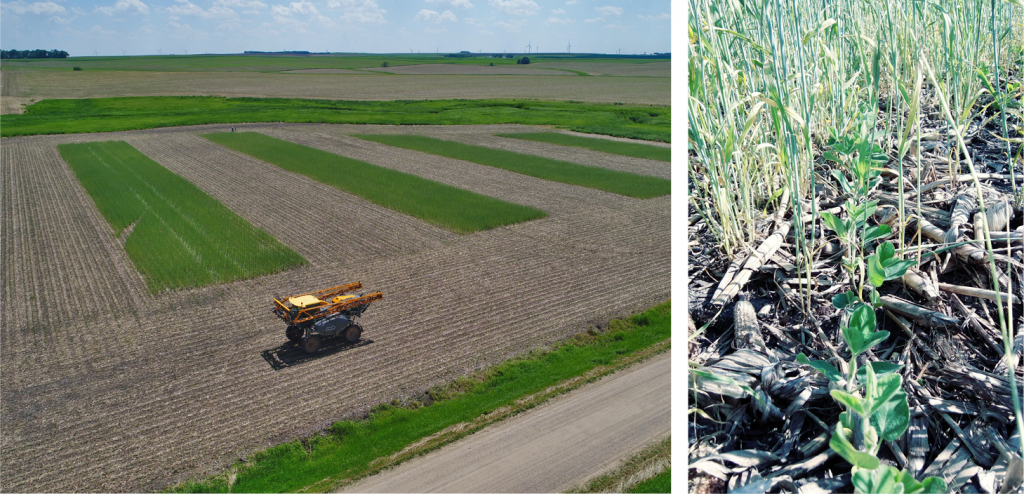
Left: An aerial photo of treatment strips at Sam Bennett’s was captured on June 7, 2019 – 27 days after planting soybeans in all strips. Cereal rye is visible in the delayed termination strips and was terminated the same date of capturing this photo. Right: Soybeans growing under the rye on June 9, 2019 – 29 days after planting soybeans.
Current guidelines determined by the Natural Resources Conservation Service and the Risk Management Agency require cover crops to be terminated on or before the date of planting soybeans at Sam Bennett’s and Jon Bakehouse’s farms (western Iowa) and before soybean emergence at Tim Sieren’s farm (southeast Iowa).[4] Bennett, Sieren and Bakehouse wanted to determine if they can increase rye biomass and improve weed control by prolonging cover crop growth until after soybean emergence without reducing soybean yield. To determine the effect of prolonging cover crop growth beyond soybean emergence, each grower compared cereal rye biomass, soybean stand count and soybean yield of strips where cereal rye was terminated near the date of planting soybean (near-plant termination) and strips where cereal rye was terminated between 16 and 52 days after planting soybean (delayed termination).
Methods
In the fall of 2018, Bennett, Sieren and Bakehouse drilled cereal rye (var. Elbon) after corn at a planting population of 1 million pure live seed per acre (PLS/ac). The subsequent spring, they planted soybeans and established treatment strips by terminating rye on two different dates at their site. Treatments were arranged in a randomized complete block design and randomly assigned to one strip per block (Figure A1). Blocks were replicated four times for a total of 8 strips at each farm.
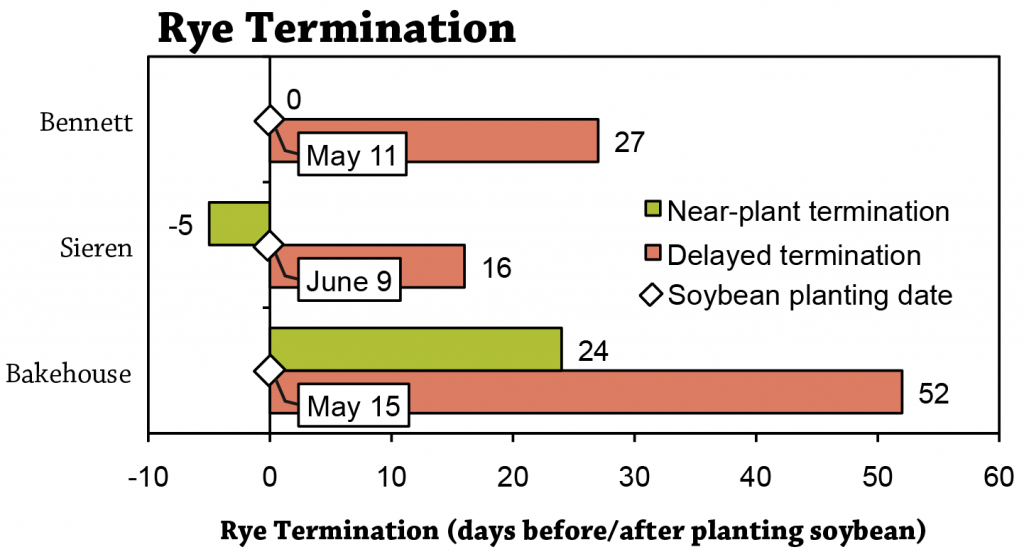
FIGURE 1. Termination of rye measured in the number of days before or after planting soybeans for both treatments at each farm. Day 0 on the horizontal axis represents the day soybeans were planted at each farm.
Bennett drilled cereal rye on Oct. 20, 2018, in 8-in. rows at 52 lb/ac. On May 11, 2019, Bennett planted soybeans in 15-in. rows at a population of 140,000 seeds/ac. To establish treatments, Bennett chemically terminated his near-plant termination strips the same date of planting soybeans using glyphosate (32 oz/ac). Bennett terminated rye with glyphosate (32 oz/ac) in his delayed termination strips on June 7, 27 days after planting soybean (Figure 1). Sam’s strips measured 350 ft long by 60 ft wide. For weed control, Bennett applied Prowl H2O and Authority MTZ to all treatment strips on May 14.

Cereal rye and soybeans in Sam Bennett’s delayed termination treatment (left) and near-plant termination treatment (right). Photo taken July 2, 2019 – 52 days after planting soybeans (May 11). Rye cover crop in the near-plant termination treatment was terminated on the same date of planting soybeans, and rye cover crop in the delayed termination treatment was terminated on June 7 – 27 days after planting soybean.
Sieren used a 7.5-in. drill to drill cereal rye on Oct. 30, 2018, at a rate of 55 lb/ac. He planted soybeans on June 9, 2019, in 7.5-in. rows and at a population of 155,000 seeds/ac. Five days prior to planting soybeans (Figure 1), on June 4, Sieren established his near-plant termination strips by terminating rye with a mix of glyphosate (32 oz/ac), Anthem Maxx (4 oz/ac), Tricor 75 DF (5 oz/ac) and AMS (2.5 lb/ac). Sieren terminated rye in his delayed termination strips on June 25, 16 days after planting soybeans, but excluded Tricor 75 DF from the herbicide mix. Five days prior to termination, Sieren observed the rye in his delayed-termination strips was already maturing and senescing with some weeds present. He thinks this burndown application may have served more as weed control than as a burndown. Sieren applied an herbicide mix of Interline (32 oz/ac) and AMS (2.55 lb/ac) to all strips on July 20 but noted the Interline was probably not necessary in the delayed-termination strips. Sieren’s strips measured 25 ft wide by 600 ft long.
Bakehouse drilled cereal rye in 8-in. rows and at a rate of 44 lb/ac on Sept. 18, 2018. Bakehouse periodically grazed the cover crop at a stocking rate of 56 AU between Oct. 29, 2018, and April 22, 2019. On May 15, Bakehouse planted soybeans in 15-in. rows at a population of 148,000 seeds/ac. Weather delayed rye termination longer in both treatments at Bakehouse’s compared to Bennett’s and Sieren’s. Bakehouse terminated rye on June 8 in the near-plant termination strips and on July 6 in the delayed termination strips – 24 days after planting soybean and 52 days after planting soybean, respectively (Figure 1). He used Durango (24 oz/ac) to terminate rye in both treatments but added Outlook (10 oz/ac) and AMS (3 lb/ac) to terminate the delayed termination strips. Bakehouse’s strips measured 30 ft wide by 1,197 ft long.
Measurements
Bennett, Sieren and Bakehouse sampled cereal rye biomass by collecting aboveground rye biomass into a paper bag from within quadrats of a specified area. They collected biomass from one or more quadrats in each strip of a block and from a minimum of two blocks. Rye biomass was air-dried then weighed. Bennett sampled biomass immediately before terminating rye in both treatments – May 11 in the near-plant termination strips and June 7 in the delayed termination strips. Sieren sampled rye biomass in all strips on June 20, and Bakehouse sampled rye biomass on May 16 in the near-plant termination strips and on July 5 in the delayed termination strips.
Soybean stand counts were carried out at each site. Bennett conducted stand counts on Sept. 4, Sieren conducted stand counts on Oct. 16, and Bakehouse conducted stand counts on Sept. 5.
Bennett and Sieren, respectively, harvested soybeans on Oct. 9 and Oct. 16. Yields were recorded for each strip and adjusted to standard moisture. Yield data could not be reported for Bakehouse.
Data analysis
Data were analyzed using RStudio statistical software (Version 1.2.1335; RStudio, Inc., Boston, MA). Means separations are reported using Least Significant Difference (LSD), and statistical significance was determined at the 95% confidence level.
Results and Discussion
Rye biomass
Rye biomass data at Bennett’s (Figure 2) represent the average amount of rye present at the time of termination in each treatment. At the time of termination, rye biomass in the delayed termination strips was statistically greater than the amount of rye biomass in the near-plant termination strips at Bennett’s. Rye biomass in the delayed termination strips averaged 4,970 lb/ac, and biomass in the near-plant termination strips averaged 540 lb/ac.
Rye biomass at Sieren’s was sampled in each treatment at incomparable stages of development – 16 days after termination in the near-plant termination strips and 5 days before termination in the delayed termination strips. Despite this, Sieren’s rye biomass data (Figure 2) can be considered a reasonably reliable representation of the amount of rye present at the time of termination in each treatment because biomass in the near-plant termination strips would not have increased during the 16-day period after terminating it and before sampling it. Similarly, because rye in the delayed termination strips was already half-dried down (nearly mature) at the time of sampling it, its biomass would also not likely have increased during the 5-day period after sampling it and before terminating it. Rye biomass at Sieren’s averaged 4,226 lb/ac in the near-plant termination strips and 4,302 lb/ac in the delayed termination strips. Biomass amounts for each treatment were statistically similar even though rye in the delayed termination treatment received 16 additional days of growth compared to rye in the near-plant termination treatment.
While Sieren’s data do not show a statistically significant difference in rye biomass, it is worth noting that biomass was numerically greater in his delayed termination strips. Analysis of Sieren’s biomass data required a more conservative approach than Bennett’s because information on the replicates from which samples were collected was not included with the samples. It is possible that including information on replicates could have resulted in a different conclusion for Sieren’s biomass data.
Bakehouse’s data show a statistically greater amount of rye biomass in the delayed termination strips compared to the near-plant termination strips (Figure 2). Similar to Sieren’s data, Bakehouse’s rye biomass data was collected at incomparable stages of the rye’s development in each treatment. Bakehouse sampled rye biomass 23 days before termination in the near-plant termination strips and 1 day before termination in the delayed termination strips. Had biomass in the near-plant termination strips been sampled 1 day rather than 23 days prior to the date of its termination, the data would have reflected an additional 22 days of growth and might have resulted in a smaller difference between treatments. Additionally, information on replicates was missing from Bakehouse’s data and required a more conservative statistical analysis as with Sieren’s biomass data, however, the conclusions drawn from Bakehouse’s data would be the same under both analyses.
Soybean stand counts
Delayed termination of rye reduced stand counts at Sieren’s (Figure 3). Average stand counts were 210,750 plants/ac and 172,050 plants/ac in his near-plant termination and delayed termination strips, respectively. Stand counts in each treatment at Bakehouse’s were statistically similar and averaged 114,750 plants/ac in his near-plant termination strips and 112,750 plants/ac in his delayed termination strips (Figure 3). Conclusions could not be drawn from Bennett’s data because it did not meet all the criteria necessary to conduct statistical analysis. The average stand count in each of Bennett’s termination-date treatments was 116,500 plants/ac (Figure 3).
Soybean yield
Soybean yield at Bennett’s and Sieren’s was not reduced by delaying termination of rye (Figure 4). At Bennett’s, yields averaged 65 lb/ac and 67 lb/ac in the near-plant and delayed termination treatments, respectively. At Sieren’s, yields in the near-plant and delayed termination treatments each averaged 70 lb/ac. Despite the reduction in soybean stand counts at Sieren’s, his soybean yield remained unaffected by delaying termination.
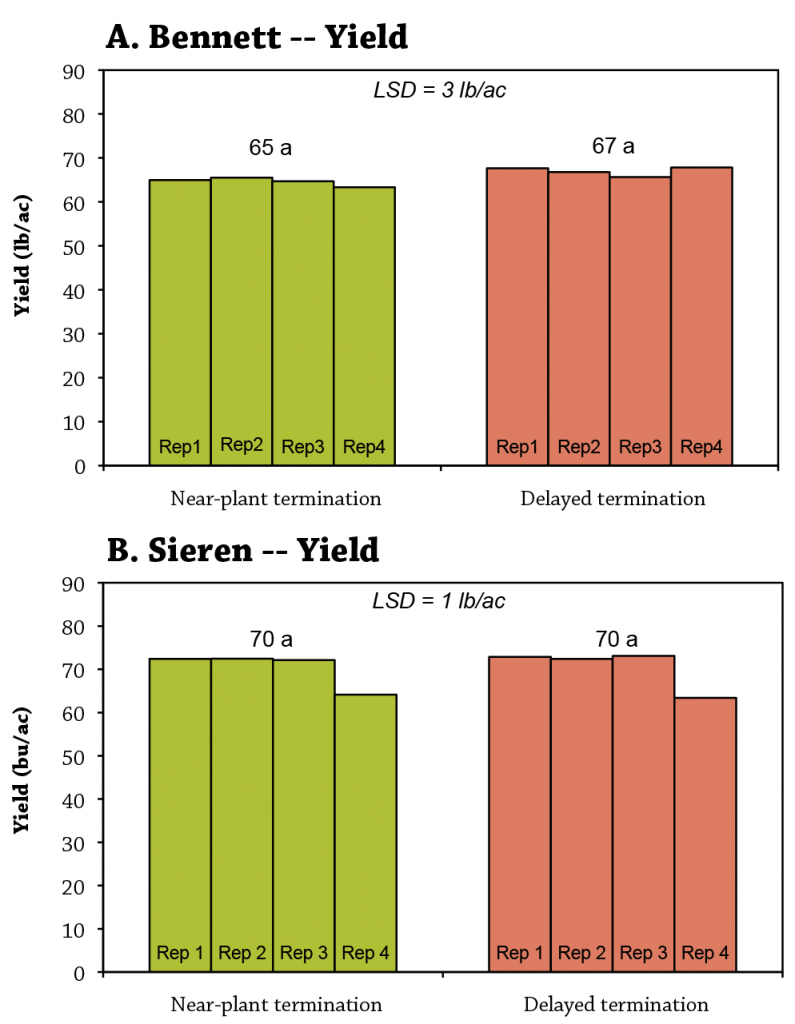
FIGURE 4. Soybean yields as affected by termination date at A) Bennett’s and B) Sieren’s in 2019. Individual bars represent rye biomass in an individual strip. Treatment means are centered above grouped bars. Within a farm, treatment means are considered statistically similar at the 95% confidence level if the difference between treatment means is equal to or less than the least significant difference (LSD). Means are followed by the same letter-ranking if they are statistically similar.
Conclusions and Next Steps

Cereal rye in Bakehouse’s delayed termination strips that “self-seeded” in 2019 and emerged the spring of 2020 following this trial. Photo taken March 31, 2020.
By delaying termination, Bennett was able to increase rye biomass on his field without reducing soybean yield. Sieren was also able to delay termination without reducing soybean yield, although soybean stand count was reduced in the delayed termination treatment and that treatment did not produce more rye biomass. While these results provide evidence that delaying rye termination up to 27 days after planting soybeans does not reduce soybean yield, results of a similar trial conducted in 2018 show otherwise.[5] In that 2018 trial conducted at two sites, rye in the delayed termination treatment produced as much as 5 times more biomass than rye in the near-plant termination treatment, and soybean yields were statistically reduced.
When asked if he plans to change any practices as a result of his participation in the trial, Sieren responded, “I plan to use more rye cover as a replacement for the first residual herbicide pass.” Even though delaying termination did not increase rye biomass at Sieren’s, he was able to use less herbicide in those strips without reducing soybean yield and also felt his July 20 herbicide pass in those strips was not necessary. Sieren commented, “I’ve been seeing weed control advantages in my use of covers in soybeans. Now I have numbers that prove it works – even in adverse conditions like those we experienced this growing season.”
Bennett also plans to continue the practice of delaying termination in soybeans. He stated, “I feel I’m gaining more benefits from the rye cover crop by delaying termination as long as possible.” When asked if he felt it was worthwhile to conduct the trial, Bennett responded, “This trial gave me confidence to delay rye termination until well after soybean emergence. I also hope to use this data in discussions with RMA about altering the cover crop termination guidelines under federal crop insurance rules.”
Bakehouse’s results are unique compared to Bennett’s and Sieren’s because rye in both of his treatments grew for longer periods after planting soybeans due to weather. While Bakehouse experienced greater rye biomass in his delayed termination treatment, it did not reduce soybean stand counts compared to the near-plant termination treatment. At the initial close of this trial, Bakehouse commented, “We will be more careful about letting cereal rye go too long before termination.” However, Bakehouse changed his tune recently after seeing cereal rye emerge this spring in the same locations where his delayed termination strips (terminated July 6) were in 2019. Rye in those treatment strips set and dropped seed. As an outcome of this trial, both Bakehouse and Bennett plan to investigate the effects of additional termination dates as well as the effect of not terminating the rye (letting the rye mature in the soybeans and re-seed itself).
Appendix – Trial Design and Weather Conditions
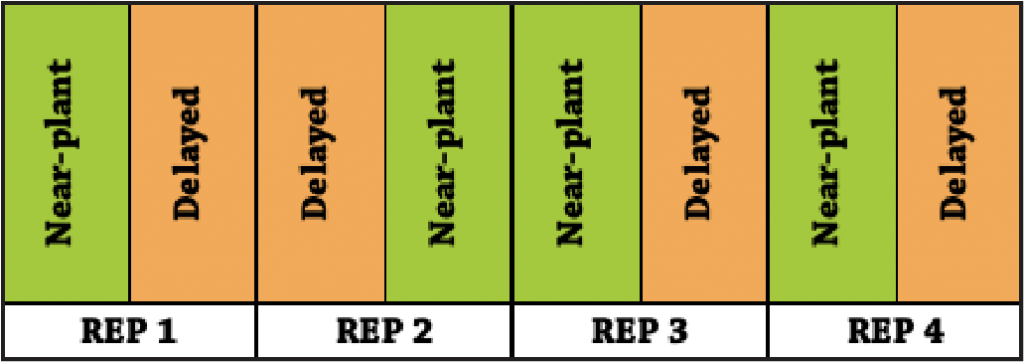
FIGURE A1. Sample experimental design used by the cooperators. The design includes randomized replications of the near-plant and delayed termination treatments. This design allowed for statistical analysis of the data.
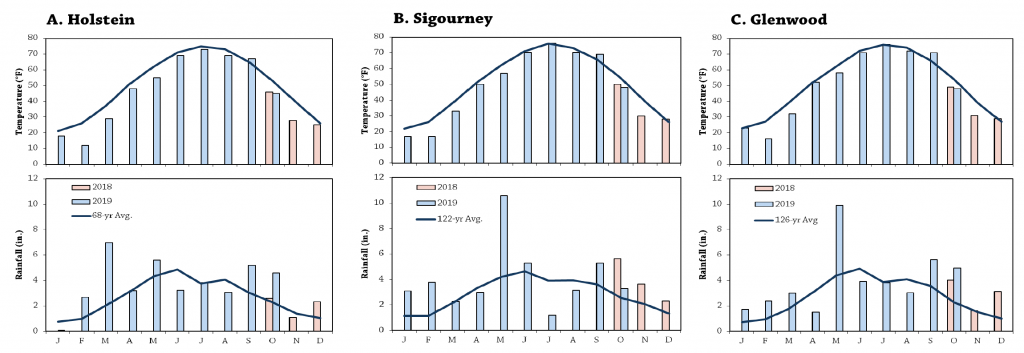
FIGURE A2. Mean monthly temperature and rainfall for Oct. 1, 2018 through Oct. 31, 2019 and the long-term averages at the nearest weather stations to each farm.[6] A) Holstein (Sam Bennett); B) Sigourney (Tim Sieren); C) Glenwood (Jon Bakehouse).
References
- Gailans, S. and S. Bennett. 2019. Cereal Rye Cover Crop for Reducing Herbicides in Soybeans. Practical Farmers of Iowa Cooperators’ Program. https://practicalfarmers.org/research/cereal-rye-cover-crop-for-reducing-herbicides-in-soybeans-2019/ (accessed March 2020).
- Nelson, H. and S. Bennett. 2018. Cereal Rye Cover Crop for Reducing Herbicides in Soybeans. Practical Farmers of Iowa Cooperators’ Program. https://practicalfarmers.org/research/cereal-rye-cover-crop-for-reducing-herbicides-in-soybeans/ (accessed March 2020).
- Basche, A.D. and M.S. DeLonge. 2019. Comparing infiltration rates in soils managed with conventional and alternative farming methods: A meta-analysis. PLOS ONE. 14: http://dx.plos.org/10.1371/journal.pone.0215702 (accessed February 2020).
- USDA Natural Resource Conservation Service. 2019. NRCS Cover Crop Termination Guidelines. Version 4. https://www.rma.usda.gov/en/Topics/Cover-Crops (accessed March 2020).
- Gailans, S., J. Boyer and T. Sieren. 2018. Terminating Cereal Rye Cover Crops After Planting Soybeans. Practical Farmers of Iowa Cooperators’ Program. https://practicalfarmers.org/research/terminating-cereal-rye-cover-crops-after-planting-soybeans/ (accessed April 2020).
- Iowa Environmental Mesonet. 2020. IEM “Climodat” Reports. Iowa State University Department of Agronomy. http://mesonet.agron.iastate.edu/climodat/ (accessed March 2020).


